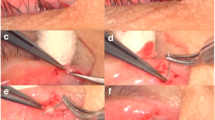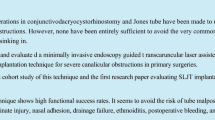Abstract
Background
The pigtail was used to create an opening at the lower punctal site in grade 0 stenosis with insertion of self-retaining tube and Mitomycin C (MMC).
Methods
The patients with acquired lower punctal stenosis (grade 0) were divided randomly into equal groups, Group A: were treated with pigtail and MMC 0.02% and Group B: were treated with pigtail alone. The pigtail was inserted through the upper punctum until its tip reached the occluded punctum, this site was incised with a scalpel (No. 11). A self-retaining bicanalicular tube was then placed.
Results
Results of 36 eyes from 26 patients were included. No differences were observed between both groups regarding epiphora score, FDD test and punctal size preoperatively. The postoperative epiphora score, there were significant differences at 1 month (P = 0.035), 3 months (P = 0.005), and 6 months after removal (P < 0.001). The FDD test, there were significant differences at 6 months (P = 0.045), 1 month (P = 0.021), 3 months (P = 0.012), and 6 months post tube removal (P = 0.005). The punctal size, both groups differed at 1 month (P = 0.045), 3 months (P = 0.03), and 6 months post tube removal (P = 0.005). Only one case (5.5%) at each group showed extrusion of the tube.
Conclusion
The pigtail probe, bicanalicular stent and MMC can be an effective method in treatment of severe punctal stenosis.


Similar content being viewed by others
Data availability
Data available on request from the corresponding author Email: masalamah@zu.edu.eg
References
Kashkouli MB et al (2003) Acquired external punctal stenosis: etiology and associated findings. Am J Ophthalmol 136(6):1079–1084
O’Donnell FE (1986) Medial ectropion: association with lower lacrimal obstruction and combined management. SLACK Incorporated, Thorofare
Seiff SR, Shorr N, Adams T (1985) Surgical treatment of punctal-canalicular fibrosis from 5-fluorouracil therapy. Cancer 56(8):2148–2149
Kashkouli MB, Pakdel F, Kiavash V (2012) Assessment and management of proximal and incomplete symptomatic obstruction of the lacrimal drainage system. Middle East Afr J Ophthalmol 19(1):60
Soiberman U et al (2012) Punctal stenosis: definition, diagnosis, and treatment. Clin Ophthalmol jul3:1011–1018. https://doi.org/10.2147/OPTH.S31904
Ali MJ et al (2015) Punctal stenosis: histopathology, immunology, and electron microscopic features—a step toward unraveling the mysterious etiopathogenesis. Ophthalmic Plast Reconstr Surg 31(2):98–102
Port AD, Chen Y-T, Lelli GJ Jr (2013) Histopathologic changes in punctal stenosis. Ophthalmic Plast Reconstr Surg 29(3):201–204
Koh CH, La TY (2013) Treatment of punctal occlusion using pigtail probe. Ophthalmic Plast Reconstr Surg 29(2):139–142
Kopp ED, Seregard S (2004) Epiphora as a side effect of topical mitomycin C. Br J Ophthalmol 88(11):1422
Sahlin S, Rose GE (2001) Lacrimal drainage capacity and symptomatic improvement after dacryocystorhinostomy in adults presenting with patent lacrimal drainage systems. Orbit 20(3):173–179
Edelstein J, Reiss G (1992) The wedge punctoplasty for treatment of punctal stenosis. SLACK Incorporated, Thorofare, pp 818–821
Kashkouli M et al (2008) External lacrimal punctum grading: reliability and interobserver variation. Eur J Ophthalmol 18(4):507–511
McLeish WM, Bowman B, Anderson RL (1992) The pigtail probe protected by silicone intubation: a combined approach to canalicular reconstruction. SLACK Incorporated, Thorofare, pp 281–283
Beyer CK (1974) A modified lacrimal probe. Arch Ophthalmol 92(2):157–157
Kersten RC, Kulwin DR (1996) “One-stitch” canalicular repair: a simplified approach for repair of canalicular laceration. Ophthalmology 103(5):785–789
Ozgur OR et al (2015) Management of acquired punctal stenosis with perforated punctal plugs. Saudi J Ophthalmol 29(3):205–209
Abd El Ghafar AS et al (2017) Perforated punctal plugs with adjuvant use of Mitomycin-C in management of acquired external punctal stenosis grades 0 and 1. Can J Ophthalmol 52(6):606–610
Ma’luf, R.N et al (2002) Mitomycin C as adjunct therapy in correcting punctal stenosis. Ophthalmic Plast Reconstr Surg 18(4):285
Kashkouli MB, Beigi B, Astbury N (2005) Acquired external punctal stenosis: surgical management and long-term follow-up. Orbit 24(2):73–78
Funding
The authors declare that no funds, grants, or other support were received during the preparation of this manuscript.
Author information
Authors and Affiliations
Contributions
All authors contributed to the study conception and design. Material preparation, data collection and analysis were performed by Moustafa Abdullah Salamah, Ahmed N Kotb, Sherif Sharaf EL Deen, and Mohammed A. Hegab. The first draft of the manuscript was written by Mohammed A. Hegab and all authors commented on previous versions of the manuscript. All authors read and approved the final manuscript.
Corresponding author
Ethics declarations
Conflict of interest
All authors declare that they have no conflict of interest in the subject matter or materials discussed in this manuscript.
Ethical approval
This research was approved by the Institutional Review Board of the Faculty of Medicine, Zagazig University, Egypt (ZU-IRB#:9372-8-5-2022) and adhered to the ethical principles outlined in the Declaration of Helsinki as amended in 2013.
Consent to participate
A written informed consent demonstrating the surgical technique and possible complications was taken from every patient included in this study.
Consent for publication
Informed consent for publication of identifiable information/images in open access journal was obtained from all study participants.
Additional information
Publisher's Note
Springer Nature remains neutral with regard to jurisdictional claims in published maps and institutional affiliations.
Rights and permissions
Springer Nature or its licensor (e.g. a society or other partner) holds exclusive rights to this article under a publishing agreement with the author(s) or other rightsholder(s); author self-archiving of the accepted manuscript version of this article is solely governed by the terms of such publishing agreement and applicable law.
About this article
Cite this article
Salamah, M.A., Kotb, A.N., El Deen, S.S. et al. Pigtail with self-retaining bicanalicular intubation combined with Mitomycin C for the treatment of acquired lower punctal stenosis. Int Ophthalmol 44, 224 (2024). https://doi.org/10.1007/s10792-024-03146-1
Received:
Accepted:
Published:
DOI: https://doi.org/10.1007/s10792-024-03146-1




